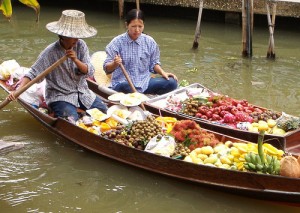- Great photos of swimming pigs.
- Great photos of Indian spice market.
- British agriculture to go Mediterranean.
Agricultural biodiversity and its perception, then and now
Hanging around the library today, I happened to pick up the March 2009 issue of Economic Botany, and was rewarded with a couple of really interesting papers on people’s perceptions of agrobiodiversity, and how it can be different to what you might think.
The first paper looked at knowledge of apple diversity among cider-makers in the United Kingdom and the United States. 1 The working hypothesis was that cider makers with a long history in the business would know more apple variety names that comparative neophytes. The results of semi-structured interviews with about 30 informants in Washington State, England, Wales and Northern Ireland suggested that this was not in fact the case. Experienced cider makers do indeed know more apple varieties, but not necessarily by name. They keep track of diversity in other ways, by taste, smell and ecology. The art of cider making lies in the blending, so the maker needs to know what each apple tastes like, on its own and in combination.
Cider makers who have a sense of rootedness to their land often know intricate details about trees in their orchards. They may know the rate at which they bloom, which trees do better in which conditions, or what the sugar levels of fruits will be on a given year. With all this knowledge, why would names have significance?
This would seem to contradict the findings of other studies which suggested that there’s a high degree of correspondence between number of local names and genetic diversity. Names might be lost, but the knowledge of diversity — and, at least for now, the diversity itself — is still there.
The second paper looks at how diversity in grapevines was perceived in the past. 2 Its subject is the Baroque altarpieces in Galicia, and in particular the twisted columns known as Solomonic. These often feature grapevine leaves, and the authors measured various morphometric variables on these representations, as well as on the real leaves of numerous varieties maintained in a local genebank. You know the kind of thing. The angle between this and that vein. The depth of the nth lobe.
They found that the representations were often very faithful, and could be used to identify specific local varieties. With a more extensive dataset (that is, more characters, and more altarpieces), it might be possible to reconstruct the history of cultivation of various now rare or extinct local cultivars. Another example of the imaginative sources of data people are looking at to get a handle on genetic erosion.
Obligatory photos of agricultural biodiversity in Thai floating market go online to stifled yawns
I’m very ignorant about SE Asia, so I assumed that the famous (or infamous) “floating market of Bangkok” would be in Bangkok, rather than over 100km away. I also didn’t really expect it to be quite the tourist trap it is. Oh well. But they do sell a remarkable variety of fruits, vegetables and other assorted agrobiodiversity there. Go to my Flickr page and leave as many identifications as you can.

Nibbles: Kerr reports, Monsanto shares, Thailand patents
- Kerr Center for Sustainable Agriculture mourns loss of agricultural biodiversity, issues report.
- Monsanto “shares with farmers the science behind the technology.” Nice of them.
- Thailand patents (transgenic) jasmine rice to “keep foreigners out of our paddy fields.” So much to say about this, so little time.
Nibbles: Traditional knowledge, Opium poppy, Fish, Bees, Earthworms, Wild horses, Camel, Fearl rabbits, Guinea savannah, Kava
- “In the face of climate change, keeping diverse, resilient ecosystems is one of the strongest tools for adaptation.”
- Getting high in Eden.
- Chinese ate freshwater fish 40,000 years ago.
- British MPs finish cleaning their moats, decide to save the honeybee.
- Worm power!
- LEISA 25:2 is out.
- Przewalski’s horse gets first ever reverse vasectomy.
- Early farmers used camel-drawn carts.
- Using Google Earth to map bunnies in Australia. And then kill them.
- Farming the savannah. What could go wrong?
- Stressed out? Try kava. With audio goodness.